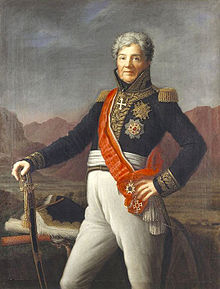- Niklaus Franz von Bachmann
-
Niklaus Leodegar Franz Ignaz von Bachmann (Näfels, 27 March 1740 - Näfels, 11 February 1831), was a Swiss general who fought in the Napoleonic Wars.
Contents
Family and early life
He was born in an aristocratic Swiss family of long-standing military traditions. Among his ancestors were Kaspar von Gallati (1535–1619) and Kaspar Freuler (1595–1651), first and fourth Colonels of the Regiment of Swiss Guards of the King of France. He was the younger son of Marechal de Camp Freiherr Karl Leonhard von Bachmann and Maria Dorothea Muller, daughter of a Colonel. His older brother was Major and Marechal de Camp Karl Josef von Bachmann, commanding officer of the Swiss Guard on the 10th of August 1792. His sister Maria Dorothea married Freiherr Franz Josef Muller von Friedberg, Prime Minister of the Prince-Abbot of St. Gallen, and was the mother of Karl Muller von Friedberg, Swiss politician, founder and first Landamman of the Canton of St.Gallen. He studied at the Jesuits' College in Feldkirch and at the Nazaren Institute in Rom before joining the Swiss regiments in the French Army in 1756.
Military career in France
Ensign in 1758, Captain in 1759 in the Regiment Widmer, Major in 1768 in the Regiment Boccard, he became a Lieutenant Colonel in 1773 and was made a Knight of the Royal and Military Order of Saint Louis in 1778. He was in charge of the training of the French troops sent to fight in North America against Great Britain in the American War of Independence and introduced the Prussian drill in the French Army. In 1779 he was promoted to Colonel and in 1789 was appointed to the Supreme War Council. The French Revolution brought with it the destruction of the Swiss Guard Regiment and the end of the Capitulations between the French Monarchy and the Swiss Confederation. Bachmann's brother, Karl Josef, was sentenced to death for his part in the defense of King Louis XVI on the 10th of August 1792 and was guillotined in September of the same year.
Military career in Sardinia and Austria
Bachmann, outraged by the fall of the Monarchy and the deaths of the King and his brother left France and moved back to Switzerland. Here he recruited his own Regiment and in 1793 entered the service of Victor Amadeus III, King of Sardinia, who was bolstering his army in fear of a French attack. Bitter enemy of the revolutionaries (whom he called "the Regicides") he fought successfully in the area of the Valley of Aosta and was promoted to Lt. General in 1794, made a Knight of the Order of Saints Maurice and Lazarus and a Count of the Kingdom of Sardinia (title he never used as he preferred the ancient title of Freiherr of the Bachmann family). After the defeat of Sardinia at the hands of Napoleon he was forced to return to Switzerland. But as soon as the Second Coalition arose against revolutionary France he entered austro-British service and commanded the Swiss troops fighting for the Coalition. In 1800 he first re-introduced to his troops the old Swiss symbol of the white cross on a red field, which had not been used anymore since the Middle Ages.[dubious ]
Stecklikrieg, Triumph and retirement
In 1802 the Swiss Diet in Schwyz made him Commander in Chief of the Swiss federal army which opposed the Army of the Helvetic Republic. In a brief campaign he completely defeated the Helvetic Army and was about to cause the collapse of the Helvetic Republic when Napoleon intervened. General Rapp sent by Napoleon to "pacify" Switzerland was angrily told by General Bachmann that had he arrived only 24 hours later he would have found Switzerland fully pacified. Mistrusted by Napoleon, without any sympathy for the new governments of either Switzerland or France Bachmann went into retirement at the age of 63.
War of the Seventh Coalition
In 1815, after the return of Napoleon from Elba the Swiss federal Diet called him back in service and made him again Commander in Chief of the Swiss Army. He commanded the Swiss Army that invaded France in 1815. Again his troops used the white cross on a red field as symbol.
After the War he received the Grand Cross of the Order of Saint Louis (France), of the Order of Leopold (Austria) and of the Order of Saints Maurice and Lazarus (Sardinia). The Swiss Diet, which did not have any Orders, gave him a ceremonial sabre with a golden hilt. Louis XVIII offered him the position of Inspector General of all the Swiss regiments in France, but he declined the offer due to his age. In 1819 he attended, as a guest of honour, the inauguration in Lucerne of the "Lion Monument" by Bertel Thorvaldsen commemorating the sacrifice of the Swiss Guard. His brother's name is engraved there on the second place in the list of the fallen. He died due to old age in 1831 in his house at the remarkable age of almost 91 years.
References
- Niklaus Franz von Bachmann in German, French and Italian in the online Historical Dictionary of Switzerland.
Categories:- 1740 births
- 1831 deaths
- French military personnel of the Napoleonic Wars
- Swiss military personnel of the Napoleonic Wars
- People from the Canton of Glarus
- Order of Saint Louis recipients
Wikimedia Foundation. 2010.

